Standards Worldwide
Standards Worldwide
Phone +49 30 58885700-07

Standard [CURRENT]
ASTM C 88/C 88M:2024
Standard Test Method for Soundness of Aggregates by Use of Sodium Sulfate or Magnesium Sulfate
- German title
- Prüfung der Raumbeständigkeit von Zuschlagstoffen mittels Natriumsulfat und Magnesiumsulfat
- Publication date
- 2024
- Original language
- English
- Pages
- 6
- Publication date
- 2024
- Original language
- English
- Pages
- 6
- DOI
- https://dx.doi.org/10.1520/C0088_C0088M-24
Product information on this site:
Quick delivery via download or delivery service
Buy securely with a credit card or pay upon receipt of invoice
All transactions are encrypted
Short description
1.1 This test method covers the testing of aggregates to estimate their soundness when subjected to weathering action in concrete or other applications. This is accomplished by repeated immersion in saturated solutions of sodium or magnesium sulfate followed by oven drying to partially or completely dehydrate the salt precipitated in permeable pore spaces. The internal expansive force, derived from the rehydration of the salt upon re-immersion, simulates the expansion of water on freezing. This test method furnishes information helpful in judging the soundness of aggregates when adequate information is not available from service records of the material exposed to actual weathering conditions. 1.2 Units- The values stated in either SI units or inch-pound units are to be regarded separately as standard. The values stated in each system are not necessarily exact equivalents; therefore, to ensure conformance with the standard, each system shall be used independently of the other, and values from the two systems shall not be combined. 1.3 Some values have only SI units because the inch-pound equivalents are not used in practice. 1.4 If the results obtained from another standard are not reported in the same system of units as used by this test method, it is permitted to convert those results using the conversion factors found in the SI Quick Reference Guide. 2 Note 1: Sieve size is identified by its standard designation in Specification E11 . The alternate designation given in parentheses is for information only and does not represent a different standard sieve size. 1.5 This standard does not purport to address all of the safety concerns, if any, associated with its use. It is the responsibility of the user of this standard to establish appropriate safety, health, and environmental practices and determine the applicability of regulatory limitations prior to use. 1.6 This international standard was developed in accordance with internationally recognized principles on standardization established in the Decision on Principles for the Development of International Standards, Guides and Recommendations issued by the World Trade Organization Technical Barriers to Trade (TBT) Committee.
ICS
91.100.30
DOI
https://dx.doi.org/10.1520/C0088_C0088M-24
Also available in
Loading recommended items...
Loading recommended items...
Loading recommended items...
Loading recommended items...
